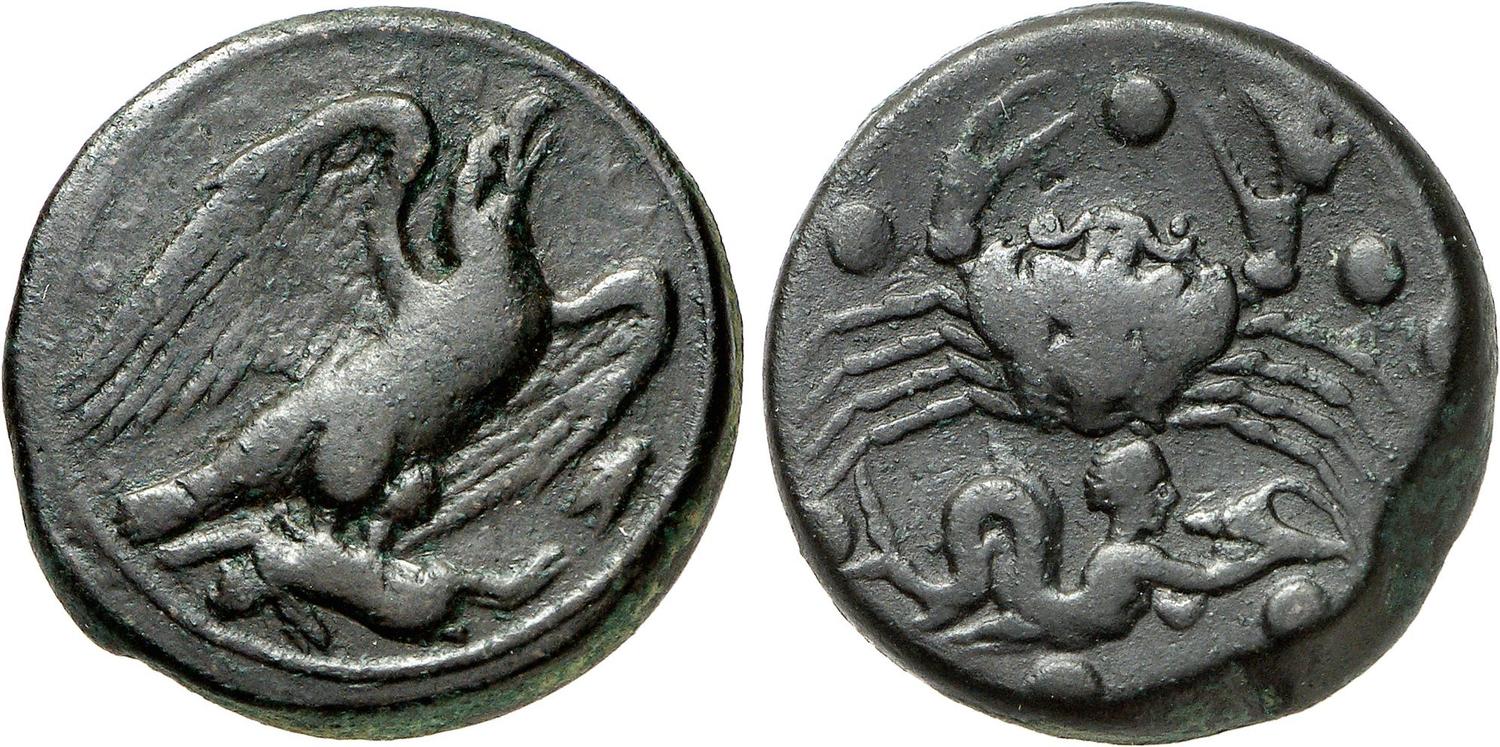S 1506 - Agrigentum, bronze, hemilitrai (415-406 BCE)
From SILVER
415 BCE - 406 BCE Bronze
Description
| ObverseInscription or printing placed on the obverse.: | Eagle right, raising head and clutching hare in its talons |
| ReverseInscription or printing placed on the reverse.: | Crab, above, fig leaf, below, Triton swimming to left and holding a shell, around, six pellets |
Mint and issuing power
| MintIdentifies the place of manufacture or issue of a numismatic object.: | Agrigentum | Ancient regionAncient region.: | Sicily | Modern countryModern country: Italy | AuthorityIdentifies the issuing power. The authority can be "pretended" when the name or the portrait of X is on the coin but he/she was not the issuing power. It can also be "uncertain" when there is no mention of X on the coin but he/she was the issuing power according to the historical sources: |
Chronology
| FromIdentifies the initial date in a range assigned in a numismatic context. | 415 BCE | toIdentifies the final date in a range assigned in a numismatic context.. | 406 BCE | PeriodTime period of the numismatic object.: Classical 480-323 BC |
Physical description
| MetalThe physical material (usually metal) from which an object is made.: | Bronze |
Median weightMedian of the weights of numismatic objects (in grams). in grams | 20.20 | DenominationTerm indicating the value of a numismatic object. Examples: tetradrachm, chalkous, denarius.: | hemilitron | StandardStandard.: |
Image

S 1506 - Agrigentum, bronze, hemilitrai Triton (415-406 BCE).jpg [1]
References
| Die study referencePublication of the study: | Westermark 20181Westermark 2018, p. 205-246, n° 612-800 | ||
| Coin series referenceReference to coin series study: | Sear I2Sear I, n° 752, HGC 23HGC 2, n° 136 | ||
| Coin series web referenceCoin series web references: | |||
Obverse dies distribution
| FrequencyFrequency of specimen in distribution. ᵖ | Number of obversesNumber of obverse dies. ᵖ (o) | % (o) | Number of coinsNumber of coins. (n) | % (n) | Die nameName(s) of the die(s). |
| 1 | 16 | 15.53 | 16 | 2.32 | T5;OL6;L7;L9;L19;S8;S10;S15;S16;S20;S21;S22;S26;S27;S36;H3 |
| 2 | 12 | 11.65 | 24 | 3.48 | O9;O10;O11;O19;O27;S18+;L11;L20;L24;S9;S25;S29 |
| 3 | 13 | 12.62 | 39 | 5.66 | T7;O8;O15;O28;L8;L10;L17;L18;L23+;S13;S30;H4;H6 |
| 4 | 11 | 10.68 | 44 | 6.39 | O12;O24+;O25+;L14;L21;S4;S11;S32;S33+;S35;H1 |
| 5 | 5 | 4.85 | 25 | 3.63 | O26;S6;S14;S24;H5 |
| 6 | 9 | 8.74 | 54 | 7.84 | O7;L4;L12;L16+;L22;L25+;S17+;S23+;S28 |
| 7 | 6 | 5.83 | 42 | 6.1 | L13;S7;S31;S34;S37+;H7 |
| 8 | 4 | 3.88 | 32 | 4.64 | T6;O4;S2;L19 |
| 9 | 7 | 6.8 | 63 | 9.14 | O2;O14+;O17;L3;L5;S1;H2 |
| 10 | 3 | 2.91 | 30 | 4.35 | O16;O22+;S12 |
| 11 | 1 | 0.97 | 11 | 1.6 | O3 |
| 12 | 3 | 2.91 | 36 | 5.22 | O23+;L1;S5 |
| 13 | 2 | 1.94 | 26 | 3.77 | T1;O6 |
| 15 | 1 | 0.97 | 15 | 2.18 | O20+ |
| 17 | 3 | 2.91 | 51 | 7.4 | T4;L2;S3+ |
| 18 | 1 | 0.97 | 18 | 2.61 | L15+ |
| 19 | 2 | 1.94 | 38 | 5.52 | O13+;O18 |
| 20 | 1 | 0.97 | 20 | 2.9 | O1 |
| 28 | 1 | 0.97 | 28 | 4.06 | T2 |
| 35 | 1 | 0.97 | 35 | 5.08 | O5 |
| 42 | 1 | 0.97 | 42 | 6.1 | O21+ |
| Total | 103 of 103 | 99.98 | 689 of 689 | 99.99 |
Reverse dies distribution
no distribution is available
Quantification
| Number of obversesNumber of obverse dies. ᵖ (o) | 103 | Number of singletons (o1)The number of singleton coins. ᵖ | 16 |
| Number of reverse diesNumber of reverse dies. (r) | 136 | Number of coinsNumber of coins. (n) | 689 |
| Coins per obverse dieNumber of coins per obverse die. (n/o) | 6.69 | Coins per reverse dieNumber of coins per reverse die. (n/r) | 5.07 |
| Reverse per obverse ratioRatio of obverse dies divided by reverse dies. (r/o) | 1.32 | Percentage of singletons (o1)number of coins (n) divided by the number of singletons (o1) ᵖ | 15.53 % |
| Original number of dies (O) (Carter 1983 formula)The estimation of the number of coins according to Carter 1983 ᵖ | 109.23 | Coins struck if 20,000 as average productivity per dieCoins made if the average productivity for obverses (according to Carter) is 20,000. ᵖ | 2,184,600 |
| Original number of dies (O) (Esty 2011 formula)The estimation of the number of coins according to the singleton formula in Esty 2011 ᵖ (O) | 121.1 | Survival rate if 20,000 as average productivity per dieSurvival rate if average productivity is 20,000. ᵖ | 0.00032 |
| Coverage (o = % of O) (Esty 1984 formula)Esty 1984 - coverage (% of O) ᵖ (o = % of O) | 97.68% | Die productivity if survival rate 1/2,000Average productivity if survival rate is 1/2,000. ᵖ | 12,615.58 |
| Weight of silver (in kg) if 20,000 coins per die (O = Carter formula)Carter 1983 * Median weight * 20000 (*10 if gold or electrum) ᵖ | n.a. | Die productivity if survival rate 1/5,000Average productivity if survival rate is 1/5,000. ᵖ | 31,538.95 |
Remarks
Most likely more than 2 workstations There are 5 series linked by obverse dies: T is for Triton; O for Octopus; L for Leaf; S for Shrimp and H for Hippocamp